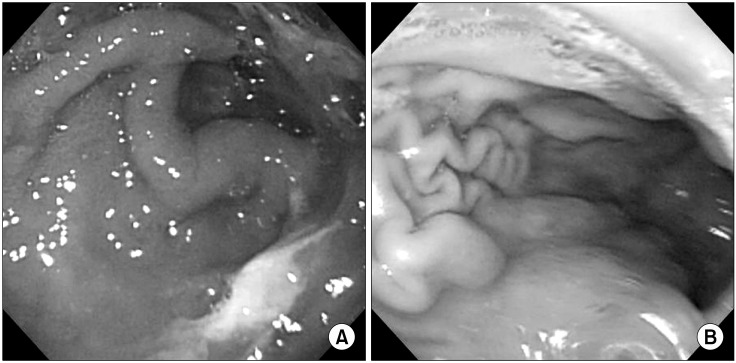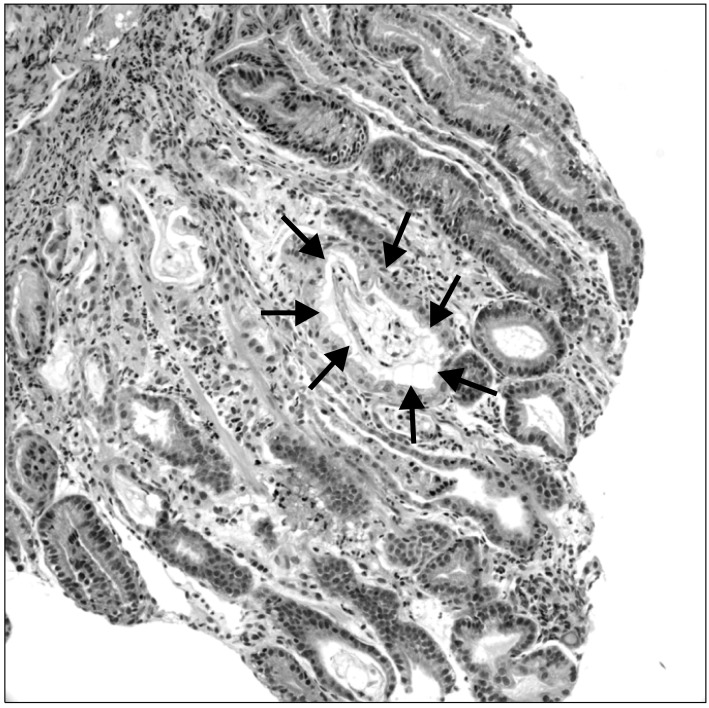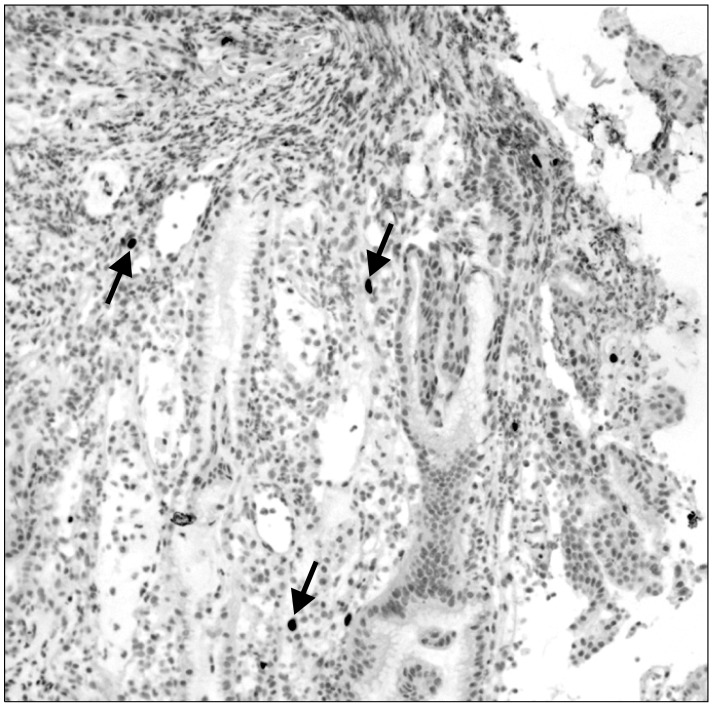Abstract
Ménétrier's disease is a rare protein-losing gastropathy characterized by hypertrophic gastric fold, foveolar hyperplasia, and hypoproteinemia with resulting peripheral edema. It is clinically evident as nonspecific gastrointestinal symptoms, including abdominal discomfort, nausea and vomiting, abdominal pain, weight loss, diarrhea, and edema. Pediatric Ménétrier's disease usually has an insidious onset and progressive, chronic clinical course and it spontaneously resolves in weeks or months. The pathogenesis of Ménétrier's disease is not clearly understood. Ménétrier's disease is thought to be associated with some gastric infections. But the cause of Ménétrier's disease is unknown, an association with cytomegalovirus (CMV) and Helicobacter pylori has been suggested. In Korea, We present the first a case of pediatric Ménétrier's disease with positive evidence of CMV and H. pylori.
Keywords: Ménétrier's disease, Cytomegalovirus, Helicobacter pylori
INTRODUCTION
Ménétrier's disease is an uncommon protein-losing hypertrophic gastropathy in childhood. It is clinically evident as nonspecific gastrointestinal symptoms, including abdominal discomfort, nausea and vomiting, abdominal pain, weight loss, diarrhea, and edema [1]. Upper endoscopy reveals giant gastric fold and histologic findings show foveolar hyperplasia and cystically dilated gastric glands. The pathophysiology of Ménétrier's disease is still undetermined [2].
Since the first reported case of Ménétrier's disease in 1888 [3] ,50 to 60 cases have been reported to date worldwide [4]. In Korea, a case of Ménétrier's disease was reported in 1967 [5] and the first pediatric case was reported in 2001 [6]. After that Ménétrier's disease association with cytomegalovirus (CMV) infection was the cases, but we present the first case of childhood Ménétrier's disease in which co-infection CMV and Helicobacter pylori.
CASE REPORT
A 3-year-old boy visited the emergency department with an 11-day duration of anorexia, vomiting, and facial and peripheral edema. He had no previous history of medical problems, surgeries, medication use, or allergies. Family history was not notable. His body temperature was 36.6℃, heart rate was 72 beats/min, respiratory rate was 24/min, and blood pressure was 88/68 mmHg. Physical examination revealed swelling of the face, lower extremities, and scrotum. Breathing sounds were clear bilaterally without crackles or wheezing. His bowel sounds were normoactive and abdominal palpation showed no tenderness or hepatosplenomegaly. Initial complete blood cell count, electrolytes, blood urea nitrogen, creatinine, transaminases and cholesterol were unremarkable. But, serum protein and albumin were decreased (2.9 g/dL and 1.9 g/dL, respectively). The patient displayed no laboratory evidence of acute or chronic inflammation (erythrocyte sedimentation rate 2 mm/hr; C-reactive protein 0.08 mg/dL). No urinary protein was detected in urinalysis. At the second day of admission, esophagogastroduodenoscopy with gastric biopsy was performed, which revealed enlarged erythematous gastric folds in the entire stomach (Fig. 1A). The diagnosis was protein-diminishing gastropathy with giant rugae (i.e., Ménétrier's disease). Along with the gastric biopsy and in-situ hybridization of specific viruses including CMV, Epstein-Barr virus and herpes simplex virus, we also performed an 13C urea breath test. The 13C urea breath test was positive(>2.0‰: cut-off value 2.0‰), prompting a 2-week regimen of lansoprazol, amoxicillin, and clarithromycin for Helicobacter pylori eradication. During the treatment, we noted the expected positive finding of recent CMV infection. Serologically, CMV immunoglobulin M was positive (IgM 1.19). A subsequent blood CMV polymerase chain reaction was positive and CMV antigenemia also was positive (18/200,000 white blood cells). Histologically, a gastric biopsy showed the proliferation of the gastric glands and cystic dilatation without increase of granulocytes or eosinophils, consistent with common histologic findings of Ménétrier's disease (Fig. 2). In addition, CMV intranuclear inclusions were detected from gastric tissue using in-situ hybridization (Fig. 3). H. pylori was not detected in Giemsa-stained sections. Although not totally normalized, the patient's appetite, peripheral edema, and hypoalbuminemia improved sufficiently to allow discharge after 8 days of supportive care such as fluid restriction, albumin infusion, diurectics, high-protein diet. Seven weeks after discharge, follow-up esophagogastroduodenoscopy with biopsy and 13C urea breath test were done. The patient did not complain of any notable symptoms and endoscopy was nearly normalized, both grossly and microscopically (Fig. 1B). But the 13C urea breath test was still positive despite 2 weeks of H. pylori eradication treatment.
Fig. 1.
Endoscopic findings of the present case. (A) Initial esophagogastroduodenoscopy shows enlarged erythematous gastric folds, and exudation in entire stomach. (B) Seven weeks after discharge, endoscopic findings were nearly normalized.
Fig. 2.
A gastric biopsy shows the proliferation of the gastric glands (surrounded by arrows) and cystic dilatation without increase of granulocytes or eosinophils (immunostain, ×400).
Fig. 3.
Cytomegalovirus (CMV) intranuclear inclusions (block dots indicated by arrows) were detected from gastric tissue using in-situ hybridization (H&E stain, ×400).
DISCUSSION
Ménétrier's disease is a rare protein-losing gastropathy characterized by hypertrophic gastric fold, foveolar hyperplasia, and hypoproteinemia with resulting peripheral edema. Pediatric Ménétrier's disease usually has an insidious onset and an overall benign course that can be managed with supportive therapy and it typically spontaneously resolves in weeks or months [7].
Ménétrier's disease is thought to be associated with some gastric infections; in pediatric cases, CMV is found frequently [8]. In 1993, Occena et al. [9] reviewed reported pediatric Ménétrier's disease cases and described the association with CMV in 70% (19 of 27) of cases. Subsequently, other reports describing CMV in association with Ménétrier's disease appeared (17 of 22, since 2000 [2,5,6,10-12]. Two Korean cases reported in 2001 and 2004 were also associated with CMV infection in preschool-age boys [6,13]. In adults, H. pylori is thought to have a role in Ménétrier's disease, rather than CMV [14].
The pathogenesis of Ménétrier's disease is not clearly understood. Transforming growth factor-α, a ligand to epithelial growth factor receptor, may play a role due to its local growth-stimulating effect via epithelial growth factor receptor binding, leading to foveolar hyperplasia and hypertrophic gastropathy in mice [15]. This specific mediator is over-expressed in adults and children with Ménétrier's disease [16]. The proposed pathogenic mechanism is mucosal damage caused by infection with CMV or H. pylori, which may involve the production of abnormal local transforming growth factor-α, which in turn stimulates cell proliferation of gastric mucosa, inhibits gastric secretion, and enhances mucus secretion [17].
Tokuhara et al. [18] reported a case of pediatric Ménétrier's disease involving co-infection with CMV and H. pylori. After eradication therapy for H. pylori, the thickened gastric folds resolved. The authors concluded that this case of pediatric Ménétrier's disease was secondary to H. pylori infection rather than CMV infection. Three years later, in 2010, Iwama et al. [19] reported another CMV and H. pylori co-infection in Ménétrier's disease case. They suggested that H. pylori had a causative role rather than CMV. In these cases of pediatric in Ménétrier's disease involving co-infection with CMV and H. pylori, eradication of H. pylori contributed to improvement of not only endoscopy finding, but also clinical symptoms [14]. Because H. pylori was thought to be causative pathogen as well as CMV in our case, H. pylori eradication was tried. Although follow-up 13C urea breath test was not changed to negative, patient's symptoms was improved and the findings of esophagogastroduodenoscopy were normalized.
One interesting thing about Ménétrier's disease is that all the co-infection cases were Asian pediatric cases, as far as we know. This may reflect the exposure pattern of CMV and H. pylori in eastern Asia. Unlike Europe and western countries, the high prevalence of these infections persists in Asia and developing countries [20]. Such higher prevalence of these microbes may increase the chance of infection in children and more commonly result in such co-infection cases.
In summary, we describe another Ménétrier's disease with CMV and H. pylori co-infection, which is a very rare case in childhood. The present case information might be helpful for better understanding the nature and course of the disease.
Footnotes
No potential conflict of interest relevant to this article was reported.
References
- 1.Baker A, Volberg F, Sumner T, Moran R. Childhood Ménétrier's disease: four new cases and discussion of the literature. Gastrointest Radiol. 1986;11:131–134. doi: 10.1007/BF02035053. [DOI] [PubMed] [Google Scholar]
- 2.Canan O, Ozçay F, Bilezikçi B. Ménétrier's disease and severe gastric ulcers associated with cytomegalovirus infection in an immunocompetent child: a case report. Turk J Pediatr. 2008;50:291–295. [PubMed] [Google Scholar]
- 3.Ménétrier P. Des polyadenomes gastriques et de leurs rapports avec le cancer de I'estomac. Arch Physiol Norm Pathol. 1888;32:236–262. [Google Scholar]
- 4.Scharschmidt BF. The natural history of hypertrophic gastrophy (Ménétrier's disease). Report of a case with 16 year follow-up and review of 120 cases from the literature. Am J Med. 1977;63:644–652. doi: 10.1016/0002-9343(77)90210-8. [DOI] [PubMed] [Google Scholar]
- 5.Moon K, Kim C, Kim K. Ménétrier's disease. Korean J Intern Med. 1967;10:733–737. [Google Scholar]
- 6.Cho JR, Kang SK, Kim YH, Choe YH. A case of Ménétrier's disease associated with cytomegalovirus infection. J Korean Pediatr Soc. 2001;44:1197–1200. [Google Scholar]
- 7.Shah KJ. Transient protein-losing gastropathy (Ménétrier's disease) in childhood. Pediatr Radiol. 1988;18:248. [PubMed] [Google Scholar]
- 8.Leonidas JC, Beatty EC, Wenner HA. Ménétrier disease and cytomegalovirus infection in childhood. Am J Dis Child. 1973;126:806–808. doi: 10.1001/archpedi.1973.02110190648013. [DOI] [PubMed] [Google Scholar]
- 9.Occena RO, Taylor SF, Robinson CC, Sokol RJ. Association of cytomegalovirus with Ménétrier's disease in childhood: report of two new cases with a review of literature. J Pediatr Gastroenterol Nutr. 1993;17:217–224. doi: 10.1097/00005176-199308000-00017. [DOI] [PubMed] [Google Scholar]
- 10.Megged O, Schlesinger Y. Cytomegalovirus-associated protein-losing gastropathy in childhood. Eur J Pediatr. 2008;167:1217–1220. doi: 10.1007/s00431-008-0791-1. [DOI] [PubMed] [Google Scholar]
- 11.Pederiva C, Ruscitto A, Brunetti I, Salvini S, Sala M. Cytomegalovirus-induced protein-losing gastropathy: a case report. Pediatr Med Chir. 2006;28:42–47. [PubMed] [Google Scholar]
- 12.Gandhi M, Nagashree S, Murthy V, Hegde R, Viswanath D. Ménétrier's disease. Indian J Pediatr. 2001;68:685–686. doi: 10.1007/BF02752288. [DOI] [PubMed] [Google Scholar]
- 13.Choi WJ, Lee BY, Lee HJ, Oh HK, Hwang JB. Cytomegalovirus-induced childhood Menetrier's disease with peripheral eosinophilia. Korean J Pediatr Gastroenterol Nutr. 2004;7:87–91. [Google Scholar]
- 14.Bayerdörffer E, Ritter MM, Hatz R, Brooks W, Ruckdeschel G, Stolte M. Healing of protein losing hypertrophic gastropathy by eradication of Helicobacter pylori--is Helicobacter pylori a pathogenic factor in Ménétrier's disease? Gut. 1994;35:701–704. doi: 10.1136/gut.35.5.701. [DOI] [PMC free article] [PubMed] [Google Scholar]
- 15.van den Berg M, Stokkers P, Rings E, Büller H. Transforming growth factor alpha in Ménétrier's disease. J Pediatr Gastroenterol Nutr. 1993;17:230–232. doi: 10.1097/00005176-199308000-00020. [DOI] [PubMed] [Google Scholar]
- 16.Bluth RF, Carpenter HA, Pittelkow MR, Page DL, Coffey RJ. Immunolocalization of transforming growth factor-alpha in normal and diseased human gastric mucosa. Hum Pathol. 1995;26:1333–1340. doi: 10.1016/0046-8177(95)90298-8. [DOI] [PubMed] [Google Scholar]
- 17.Faure C, Besnard M, Hirsch A, Mougenot JF, Peuchmaur M, Cezard JP, et al. Chronic hypertrophic gastropathy in a child resembling adult Ménétrier's disease. J Pediatr Gastroenterol Nutr. 1996;23:419–421. doi: 10.1097/00005176-199611000-00010. [DOI] [PubMed] [Google Scholar]
- 18.Tokuhara D, Okano Y, Asou K, Tamamori A, Yamano T. Cytomegalovirus and Helicobacter pylori co-infection in a child with Ménétrier disease. Eur J Pediatr. 2007;166:63–65. doi: 10.1007/s00431-006-0183-3. [DOI] [PubMed] [Google Scholar]
- 19.Iwama I, Kagimoto S, Takano T, Sekijima T, Kishimoto H, Oba A. Case of pediatric Ménétrier disease with cytomegalovirus and Helicobacter pylori co-infection. Pediatr Int. 2010;52:e200–e203. doi: 10.1111/j.1442-200X.2010.03130.x. [DOI] [PubMed] [Google Scholar]
- 20.Ozden A, Bozdayi G, Ozkan M, Köse KS. Changes in the seroepidemiological pattern of Helicobacter pylori infection over the last 10 years. Turk J Gastroenterol. 2004;15:156–158. [PubMed] [Google Scholar]





